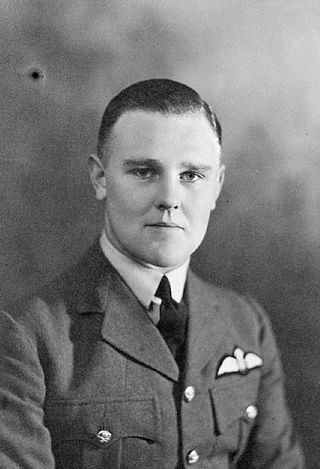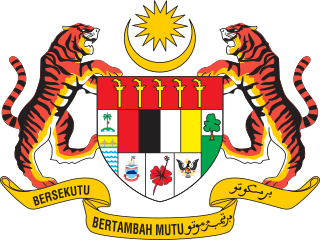
The fall of Singapore, also known as the Battle of Singapore, took place in the South–East Asian theatre of the Pacific War. The Japanese Empire captured the British stronghold of Singapore, with fighting lasting from 8 to 15 February 1942. Singapore was the foremost British military base and economic port in South–East Asia and had been of great importance to British interwar defence strategy. The capture of Singapore resulted in the largest British surrender in its history.

Squadron Leader Arthur Stewart King Scarf, VC was a Royal Air Force pilot and a recipient of the Victoria Cross, the highest award for gallantry in the face of the enemy that can be awarded to British and Commonwealth forces.

The Japanese 25th Army was an army of the Imperial Japanese Army during World War II, noted for its role in the Malayan Campaign and the Battle of Singapore.

The Royal Malay Regiment is the premier unit of the Malaysian Army's two infantry regiments. At its largest, the Malay Regiment comprised 27 battalions. At present, three battalions are parachute trained and form part of the Malaysian Army Rapid Deployment Force. Another battalion has been converted into a mechanised infantry battalion while the remaining battalions are standard light infantry. The 1st Battalion Royal Malay Regiment acts as the ceremonial foot guards battalion for the Yang di-Pertuan Agong, and is usually accompanied by the Central Band of the Royal Malay Regiment. As its name suggests, the regiment only recruits ethnic Malays.

The Battle of Pasir Panjang, which took place between 13 and 15 February 1942, was part of the final stage of the Empire of Japan's invasion of Singapore during World War II. The battle was initiated upon the advancement of elite Imperial Japanese Army forces towards Pasir Panjang Ridge on 13 February.

Taiping is a town located in Larut, Matang and Selama District, Perak, Malaysia. It is located approximately 48 km (30 mi) northwest of Ipoh, the capital of Perak, and 78 km (48 mi) southeast of George Town, Penang. With a population of 245,182, it is the second largest town in Perak after Ipoh, the state capital.

The Malayan campaign, referred to by Japanese sources as the Malay Operation, was a military campaign fought by Allied and Axis forces in Malaya, from 8 December 1941 – 15 February 1942 during the Second World War. It was dominated by land battles between British Commonwealth army units and the Imperial Japanese Army, with minor skirmishes at the beginning of the campaign between British Commonwealth and Royal Thai Police. The Japanese had air and naval supremacy from the opening days of the campaign. For the British, Indian, Australian, and Malayan forces defending the colony, the campaign was a total disaster.

Bukit Larut is a hill resort in Malaysia located in the state of Perak, Malaysia, 10 kilometres southwest from Taiping. It was established under the direction of British colonists in 1884 as a place of observation for tin mining activity and as a retreat for the English people who were based in nearby Larut and Taiping. The area was initially named Maxwell Hill after the British Malaya administrator George Maxwell, and was renamed as Bukit Larut in 1979.

The Rejimen Askar Wataniah is the military reserve force of the Malaysian Army.

Malaya, then under British Administration, was gradually occupied by the Japanese between 8 December 1941 and the Allied surrender at Singapore on 16 February 1942. The Japanese remained in occupation until their surrender to the Allies in 1945. The first Japanese garrison in Malaya to lay down their arms was in Penang on 2 September 1945 aboard HMS Nelson.

Kamunting is a town in Larut, Matang and Selama District, Perak, Malaysia. It is the biggest satellite town of Taiping.
Kota Ngah Ibrahim or Ngah Ibrahim's Fort is a fort of historical value in Taiping, Larut, Matang and Selama District, Perak, Malaysia. The fort is located at Jalan Taiping-Kuala Sepetang road near Matang town.

The 1st Malaya Infantry Brigade was a regular infantry brigade formed in 1939 with its headquarters in Singapore immediately after the outbreak of hostilities in Europe. The Brigade participated in the Battle of Singapore against the Japanese until the surrender of the garrison in February 1942.

The Larut Wars were a series of four wars started in July 1861 and ended with the signing of the Pangkor Treaty of 1874. The conflict was fought among local Chinese secret societies over the control of mining areas in Perak which later involved rivalry between Raja Abdullah and Ngah Ibrahim, making it a war of succession.

Tan Sri Dr. Lim Swee Aun was a Malaysian Chinese politician from the Malaysian Chinese Association, and a Cabinet member.

The British Military Administration (BMA) was the interim administrator of British Malaya from August 1945, the end of World War II, to the establishment of the Malayan Union in April 1946. The BMA was under the direct command of the Supreme Allied Commander South East Asia, Lord Louis Mountbatten. The administration had the dual function of maintaining basic subsistence during the period of reoccupation, and also of imposing the state structure upon which post-war imperial power would rest.
Dalforce, officially the Singapore Overseas Chinese Anti-Japanese Volunteer Army was an irregular forces/guerrilla unit within the British Straits Settlements Volunteer Force during World War II. Its members were recruited among the ethnic Chinese people of Singapore. It was created on 25 December 1941 by Lieutenant Colonel John Dalley of the Federated Malay States Police Force. The unit was known to the British colonial administration as Dalforce, after its chief instructor and commanding officer, John Dalley, whereas the Chinese in Singapore only knew it as the Singapore Overseas Chinese Anti-Japanese Volunteer Army. This formation took part in the Battle of Singapore and some members conducted a guerrilla campaign against Japanese forces during the Japanese occupation. The British noted how ferociously the Chinese volunteers in Dalforce fought, earning them the nickname Dalley's Desperadoes.

The 2/30th Battalion was an infantry battalion of the Australian Army that served during World War II. Raised in late 1940 as part of the all volunteer Second Australian Imperial Force, the battalion formed part of the 27th Brigade, which was assigned to the 8th Division. In mid-1941, the battalion was deployed to Malaya, as the garrison there was increased amidst rising tensions in the Pacific. In early1942, it fought against the Japanese during the Malayan Campaign and the Battle of Singapore, where it was captured in February 1942. Many of the 2/30th's personnel died in captivity before the war ended in August 1945.

Terendak Camp is a Malaysian Army military base located in Sungai Udang, Central Melaka District, Melaka, Malaysia. It belonged to the Commonwealth of Nations before being handed over to the Malaysian Armed Forces in 1970. It is right next to the Sungai Udang Camp.
The Cheras War Cemetery is the final resting place for Allied personnel who were killed during World War II, particularly the Malayan Campaign and the Japanese occupation of Malaya. Servicemen who died after the war or during their posting in northern Malaya prior to the Malayan Emergency are also interred here.


















